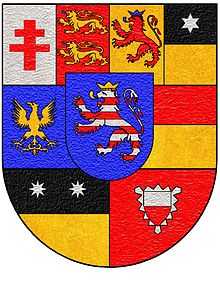Hesse-Wanfried
The mini-state Hesse-Wanfried existed from about 1700 to 1731. It was a principality (Landgraviate) of the Holy Roman Empire in the area of the today's Land of Hesse. Governed by a cadet line of the House of Hesse under the sovereignty of the land of Hesse-Kassel.
History
Maurice the Learned (1572–1632) was Landgrave of Hesse-Kassel from 1592 until 1627 when he abdicated in favour of his son William V (1602–1637), his younger sons receiving apanages which created several cadet lines of the house (Hesse-Rotenburg, Hesse-Eschwege and Hesse-Rheinfels), of which, with amalgamation, that of Hesse-Rheinfels-Rotenburg survived till 1834.
In 1627 Ernest (1623–1693), a younger son of Maurice, Landgrave of Hesse-Kassel (or Hesse-Cassel), received Rheinfels and lower Katzenelnbogen as his inheritance, and some years later, on the deaths of two of his brothers, Frederick, Landgrave of Hesse-Eschwege (1617–1655) and Herman IV, Landgrave of Hesse-Rotenburg (1607–1658), he added Eschwege, Rotenburg, Wanfried and other districts to his possessions. Ernest, who was a convert to the Roman Catholic Church, was a great traveller and a voluminous writer. About 1700 his two sons, William (d. 1725) and Charles (or Karl) (d. 1711), divided their territories, and founded the families of Hesse-Rotenburg and Hesse-Wanfried.[2] The latter family died out in 1755, when William's grandson, Constantine (d. 1778), reunited the lands except Rheinfels, which had been acquired by Hesse-Kassel in 1735, and ruled them as Landgrave of Hesse-Rotenburg.
The governing Landgraves of Hesse-Wanfried
Notes
References
Further reading
|
|---|
| The generations start from the children of Herman, Landgrave of Hesse-Rotenburg and his brother Ernest, Landgrave of Hesse-Rotenburg | | | 1st Generation | | |
|---|
| | 2nd Generation | |
|---|
| | 3rd Generation | |
|---|
| | 4th Generation |
- Landgrave Ernest
- Charles Emmanuel
- Landgrave Alois
- Landgrave Christian
- Landgrave Charles
- Landgrave Ernest
|
|---|
| | 5th Generation | |
|---|
|
|
|---|
| The generations start from the children of Herman, Landgrave of Hesse-Rotenburg and his brother Ernest, Landgrave of Hesse-Rotenburg | | | 1st generation | |
|---|
| | 2nd generation |
- Landgravine Eleonore
- Maria Eleonore, Countess Palatine of Sulzbach
- Elisabeth, Princess of Nassau-Hadamar
- Landgravine Sophie
- Landgravine Maria Amelie Wilhelmine
- Joaneta, Abbess of Essen
- Ernestina, Countess of La Cerda de Villa Longa
|
|---|
| | 3rd generation | |
|---|
| | 4th generation | |
|---|
| | 5th generation |
- Clotilde, Princess of Hohenlohe-Waldenburg
|
|---|
|
 This article incorporates text from a publication now in the public domain: Anonymous (1911). "Hess-Cassel". In Chisholm, Hugh. Encyclopædia Britannica 13 (11th ed.). Cambridge University Press. p. 410.
This article incorporates text from a publication now in the public domain: Anonymous (1911). "Hess-Cassel". In Chisholm, Hugh. Encyclopædia Britannica 13 (11th ed.). Cambridge University Press. p. 410. This article incorporates text from a publication now in the public domain: Anonymous (1911). "Hesse-Rotenburg". In Chisholm, Hugh. Encyclopædia Britannica 13 (11th ed.). Cambridge University Press. p. 413.
This article incorporates text from a publication now in the public domain: Anonymous (1911). "Hesse-Rotenburg". In Chisholm, Hugh. Encyclopædia Britannica 13 (11th ed.). Cambridge University Press. p. 413.